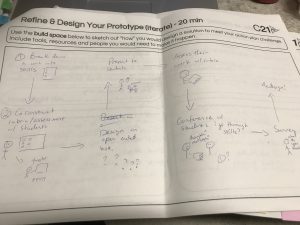After leaving our second F2F I left feeling completely motivated and excited about what I was going to research, it hit the mark for our school’s focus and was something I think will absolutely help my students and is related to the feedback they gave me. But now I feel like I’m staring up at this big tall wall and I’m a bit nervous to start picking it up.
My question is “How might we shift teaching methods in math towards differentiation and risk-taking to encourage student buy-in and creativity?”
My question in itself is something that could be used to simply innovate my classroom, but I feel it’s something I should push through our whole Middle School. After looking through the feedback from our Middle School students, and discussions with our High School teachers I know that risk-taking in math is something that’s severely lacking. We have great content in our lessons, but not much opportunity for differentiation and making mistakes.
After looking through the resources and feedback from my peers I’ve been so excited to go through the suggestions and connect with the people that were recommended.
What I would like to do is not reinventing the wheel, and it’s not groundbreaking, but it’s new to me and new to our Middle School. I feel that this is the stage in my research where I will really have to force myself to write and blog, because as our coaches said at the F2F, your perspective and ideas could be exactly what someone else needs to hear. There are a lot of amazing math teachers out there that are already doing this and I’m excited to learn how to do what they are doing.
To that end here is my plan so far explained with stick figures 
First I’ll be looking through our next math unit and finding or designing an open-ended task, then with my students we will co-construct a rubric of what en excellent math response looks like. Through this I’m hoping to encourage students to realize that I am interested more in the process of problem solving and critical thinking and not the answer. I’m also hoping that since they are a part of the process of designing the rubric they will have more buy-in and be more aware of what they are being asked to do.
After they complete the task I will assess and write feedback on the rubric, we will then sit down and conference about how they did. During that conference we will decide together how the student did and what to work on moving forward.
From there I will then conference with the class and ask about how they felt this went. Did it help them feel more confident in taking risks to solve the problems? Did it help them build interest in the math itself? Were my strong kids as engaged as my students that consider themselves bad at math?
I also think this will be almost another starting point for me and I know I should slow down but all I can think of is the snowball effect of my question and how it will spurn on more questions and more ideas. Is anyone else finding this?
I look forward to sharing more and hearing more from everyone in the Cedar group.
@edaigle @lmitchell @mbrims @jbairos


I love your stick figure plan! And, I agree, involving students in the co-creation of the assessment rubric is likely to create more buy-in and awareness of what is important to demonstrate. I wonder, could students also assess their own work or the work of others?
A good experiment always yields more questions… welcome to design thinking! It’s really all about noticing, reflecting and new actions.